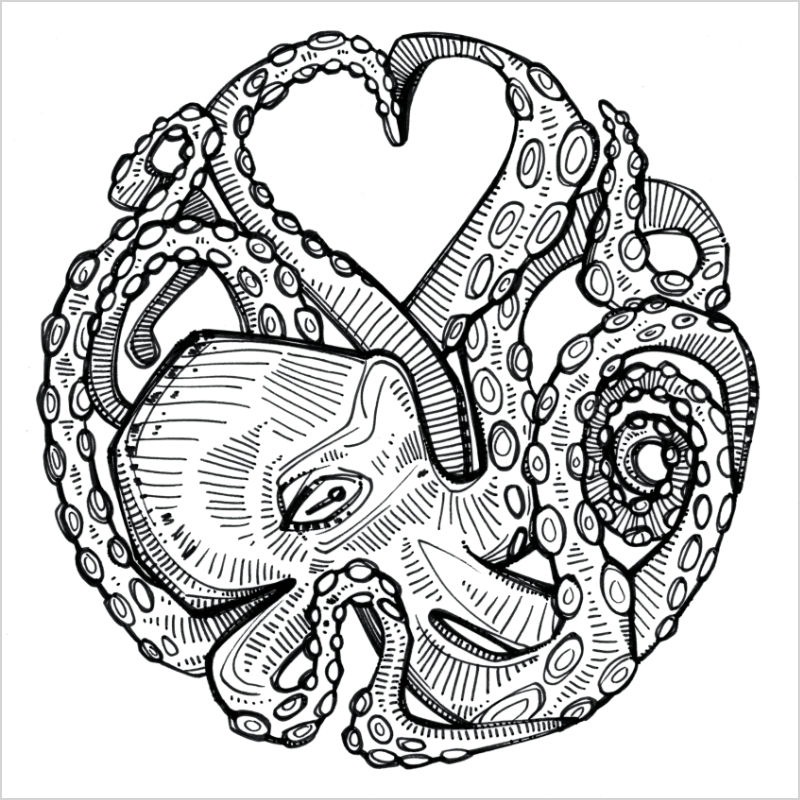Blog / 2024 / Can You See Time?
September 3, 2024
I’ll be sending out this glow-in-the-dark sticker to my monthly sticker club members at the beginning of October.
AI image generators have featured on this blog before: I’ve vlogged about the financial concerns and written about how this tech strips us of context. I used Craiyon to make the AI octopuses that feature at the end of the video, and I was inspired to think about time by reading Kening Zhu’s article about AI as a new magic.

Octopus Heart
2024
ink on paper
6 x 6 inches
The original octopus drawing is available for $80 plus shipping (and tax if you live in New Jersey)—contact me if you’re interested. You can buy prints and other pretty things here in my print shop.

VIDEO TRANSCRIPT
For five years, I’ve been sending out about seventy stickers a month to my sticker club members. Mostly, the designs are straightforward versions of the art they represent, just in sticker form, but, now and again, I’ll throw in some sparkle.
Or some glow! A few months ago, I decided to make my first glow-in-the-dark sticker. I knew I needed to make a new design, something that could take full advantage of the glow factor, and I liked the idea of an octopus, because they’re such extravagantly strange creatures already, even without a glow.
At this point, I went into a kind of “image generator mode.” I started doing what companies who own AI image generators have already done: I trained my brain. Beginning with the prompt “image of an octopus that would look good as a glow-in-the-dark sticker,” first I looked back at all octopus drawings and paintings I’d made, starting with a marker drawing in 2015 and then the painting it inspired. Then there was the octopus making a heart with its tentacles—I rather liked that. And then the ABC book dumbo octopus, the dancing one in the upper left of this album cover I designed, and the stealth one zooming through the bottom of this painting. I did a surreal octopus painting in 2023 that I later turned into this coloring book page.
Taking all that info together, I decided to use the coloring book page as the base for the new design, since it was the closest to a glow-in-the-dark sticker already in that it has lots of white space that can glow.
I did some initial sketching, trying to decide what overall shape the sticker would be. And then I settled on a circle with the octopus making a heart with its tentacles. Next, I began working out what all the rest of the tentacles would do—and also toying with giving the octopus a polka dot pattern on its skin. I made a first attempt at a final drawing, but I wasn’t totally happy with the tentacles and I didn’t love the net of lines I’d used to differentiate the animal from the background.
So I traced that drawing and started reworking the tentacles again. And again. So many reworkings. If I were not just a single human in what I’ve dubbed “image generator mode”—if I were instead an AI image generator—I’d have all the octopus images ever published on the web as my source material, helping me to find the most pleasing arrangement of tentacles. All that info would live in my robotic version of a mind, ready for use in this task.
As a person, I may have my 21 years of professional art-making to help me determine what’s a pleasing design, but then I have only the images I’ve seen and those I’ve made along with the stuff I’ve read about octopus tentacles. And all that is information I need to review in order to have it front of my mind as I work on this design.
I traced the pencil sketch and made this final drawing in ink on paper, but in a sense this was just the beginning. I scanned the drawing and then played with it digitally, refining the lines using a tablet and a stylus pen. Eventually I transformed the drawing into this design.
I don’t think that this is what an AI image generator would come up with. There’s too much of me in it. Still, there’s definitely a similarity in our process, to go along with the obvious and oft-named differences—differences like the fact that I’m a flesh-and-blood person and it’s not, or like the fact that, when I make my images, I don’t get paid nearly as much as the companies that own AI do for their work.
But the difference I’m interested in here is time. I know the process looks quick because I sped it up to make this video more interesting, but I spent hours on this one design. Meanwhile, an AI image generator could have come up with a multitude of images in that time.
The time I spent doesn’t necessarily make my image better, but it’s still a part of the image. And it leaves me wondering: is this something we can sense when we look at human-made art? Does that time give the image a kind of glow? Something that we can see if we turn off distractions and really look?
Did this post make you think of something you want to share with me? I’d love to hear from you!
To receive an email every time I publish a new article or video, sign up for my special mailing list.

